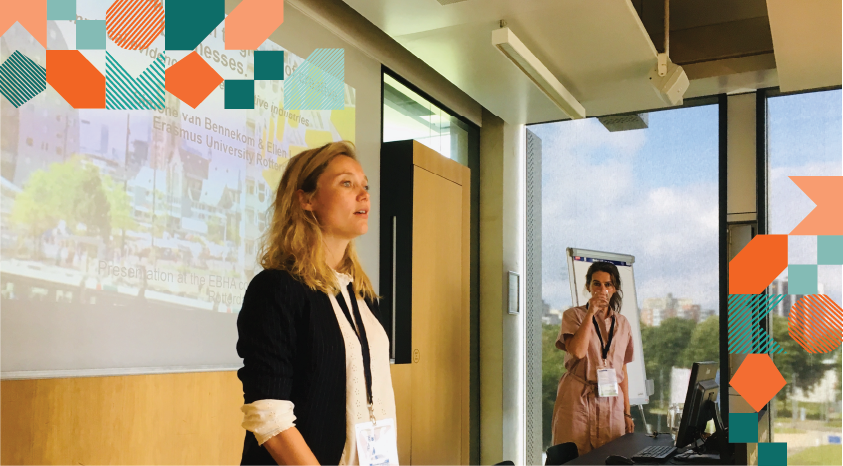Entrepreneurial firm growth: creative industries are ready to inspire!
Simone van Bennekom and Ellen Loots
Outputs (revenues, profits) and inputs (employees, investments) often define enterprises’ successes. However, as many entrepreneurs recognise: first, growth is often episodic and erratic, and, second, different dimensions of growth exist next to increasing sales and FTEs. The question now at hand is how enterprises can deal with diverging growth challenges.
Tackling a double success criterion
Simone van Bennekom and Ellen Loots investigated how enterprises in cultural and creative industries manage to grow while experiencing tensions between creative and commercial demands. Creative industries are characterised by craftmanship, imagination, artistic quality, and innovativeness. They include the production of the arts (literature, music, performing, and visual arts) and activities such as film, media, television, radio, computer games, advertising, architecture, design, fashion, and museums.
Typically, firms in creative industries deal with radical uncertainties regarding the perceived quality of their products: nobody knows whether a movie will be a blockbuster or an advertising campaign will be successful. The attention economy turns these industries into winner markets where firm growth is unpredictable and reserved for the happy few. How do the ‘winners’ in these markets explain their winning position? And what can be learned from their experiences?
A dozen of interviews with market leaders in these industries, conducted by van Bennekom showed that entrepreneurs in creative industries need to understand the value creation and conversion processes in their industry to be able to survive or develop. In other words, in order to fit in, they need to understand the industry recipe. None are aversive to the commercial side of the business.
Consumer, peer, and expert recognition
In some cases, these entrepreneurs make sure to speak to consumers’ wishes. Alternatively, creative firms proactively seek approval from peers and experts, such as reviewers or professionals that make programme decisions, for example in music or museums. It is no secret that there are firms that invest in generating ‘buzz’ for their products, especially in B2C settings where the attention of many customers leads to economies of scale.
Van Bennekom explains: “When possible, the entrepreneurs try to create this recognition and compete for rewards and awards, which can draw the attention of people. They apply different techniques to gain such ‘symbolic capital’.ii It is in the DNA of creative entrepreneurs, and other entrepreneurs can learn from these practices.” Fitting in is only a starting point. Standing out is another thing.
Quality, impact, and revenues
Overall, entrepreneurs in creative industries see the creation of value rather in visionary terms than in monetary terms. A key finding of the research is that founders of large and successful creative firms in the Netherlands strive for quality, impact, and financial gain, and feel that firm development relates to all three. Van Bennekom:
“Revenues are necessary, but profit maximisation is not the aim of many creative firms. Only focusing on profit maximisation can hamper the innovative capacity of the firm.”
Internationalisation and digitalisation activities have helped some entrepreneurs to create resource advantages vis a vis competitors. What works depends on both the industry and timing. Some advertising agencies in a B2B context provided digital services to their early-stage clients and were able to grow together with these clients. For an architecture firm, an international landmark project garnered attention and a growth leap. In the music industry, it was a matter of jumping on the digitalisation train to accommodate customers’ and clients’ changing needs.
Future challenges
What are the challenges ahead? Loots suggests that quite some firms in creative sectors are engaged in a ‘battle for talent’: “When the quality of their outputs depends on the quality of their workers, creative firms want the best workers in their teams. At present, it is not always easy to keep them.”
Another challenge is the sustainability requirements toward the 2030 European Climate Target Plan and the intention to achieve climate neutrality in the EU by 2050. This puts demands on the production and consumption of creative goods and services. As Loots explains: “Creative sectors will need to adjust their modes of production, and stimulate other ways of consumption. It is imaginable that music festivals become more local, fashion consumption becomes more sustainable, and resource-intensive sectors such as textile and architecture embrace the circular paradigm. Whereas the European policy may be quite demanding for many enterprises, firms in creative industries can be expected to come up with innovative solutions, because of their creative attitudes and societal orientations.”
Ready to inspire
Such creative qualities have recently been acknowledged by the Dutch Ministry of Economic Affairs and Climate. Firms in creative industries are recognised for their capacity to develop innovations that address societal challenges. In 2023, creative industries will play a major role in upscaling innovations with impact through the knowledge and innovation agenda ‘Societal Earning capacity’.iii How such an important role will translate into the growth of single firms remains to be seen, but van Bennekom and Loots are optimistic for the future:
“As a marked Top Sector of the Dutch economy, creative industries are ready to inspire. The trend toward sustainable growth and staying within the planetary boundaries is omnipresent, and younger generations are susceptible to this. It would be great to see creative enterprises be rewarded for their innovations and impact missions.”
Article: Ellen Loots & Simone van Bennekom (2022) Entrepreneurial firm growth in creative industries: fitting in … and standing out!, Creative Industries Journal, https://doi.org/10.1080/17510694.2022.2025710

Simone van Bennekom
A cultural economist and entrepreneur, owner of The Soft Power Company. She has extensive experience as an adviser to businesses and the creative sector. She contributes to the mission-driven policy of the Ministry of Economic Affairs and Climate, as head of a programme on international innovation and market expansion in the creative industry (https://www.clicknl.nl/creativenl/).

Ellen Loots
An assistant professor in cultural economics and entrepreneurship at Erasmus University Rotterdam. She is specialised in arts management, cultural organisations, and creative entrepreneurship, and has an interest in the motivations and behaviours of individuals and organisations in creative industries. Social challenges such as justice, community, and sustainability influence many of her choices in research and teaching.
